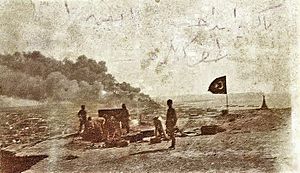Battle of Binagadi facts for kids
Quick facts for kids Battle of Binagadi |
|||||||
|---|---|---|---|---|---|---|---|
| Part of the Armenian–Azerbaijani War in the Caucasus Campaign of World War I & Southern Front of the Russian Civil War | |||||||
 Ottoman artillery bombarding the city. |
|||||||
|
|||||||
| Belligerents | |||||||
| Commanders and leaders | |||||||
The Battle of Binagadi (Azerbaijani: Binəqədi döyüşü; Turkish: Binegedi savaşı) was an important fight during World War I. It happened from August 26 to August 31, 1918. This battle was a key part of the larger Battle of Baku.
The fight was between two main groups. On one side were the Ottoman and Azerbaijani forces, led by Nuri Pasha. On the other side were British, Armenian, and White Russian forces, led by Lionel Dunsterville. For a short time, even Soviet Russia joined the fight.
Contents
Why Did the Battle of Binagadi Happen?
The Caucasus Front Changes
In 1917, a big change happened in Russia. The Tsar, who was the ruler, stepped down. This caused the Russian army in the Caucasus region to fall apart. Many Russian soldiers left the front lines and went home.
To fill the gap, a new group called the Special Transcaucasian Committee was formed. This committee tried to manage the areas that Russia had taken over during the war.
New Governments Form
Later in 1917, the first independent government in Transcaucasia was created. It was called the Transcaucasian Commissariat. This happened after the Bolsheviks took power in Russia.
In December 1917, this new committee agreed to a ceasefire with the Ottoman army. This ceasefire was called the Armistice of Erzincan.
Transcaucasia Declares Independence
In February 1918, a group called the Sejm decided to declare independence for Transcaucasia. On February 24, 1918, they officially announced the Transcaucasian Democratic Federative Republic.
Around this time, a peace treaty was signed between the Ottoman Empire and Russia. This treaty, called the Treaty of Brest-Litovsk, changed the borders. It gave the cities of Batum, Kars, and Ardahan to the Ottoman Empire.
Tensions Rise in Baku
In March 1918, tensions grew in the city of Baku. The commander of the Azerbaijani division, General Talyshinski, was arrested. This made many Azerbaijanis in Baku upset.
Then, there was a misunderstanding about an Azerbaijani ship. This led to a very difficult period called the March Days. During these days, there was a lot of fighting and violence in Baku. This event caused more problems across Azerbaijan.
Azerbaijan Seeks Freedom
In May 1918, Azerbaijan declared its own independence. Their main goal was to take control of Baku. The Ottoman Empire decided to help Azerbaijan achieve this goal. Military operations to capture Baku began in June 1918.
What Happened During the Battle?
Capturing Key Hills
The Battle of Binagadi was a very important part of the larger Battle of Baku. The main goal of this battle was to capture two important hills. These were Hill 311 and Hill 364, located near the village of Binagadi.
The battle started on August 26. The 13th Infantry Regiment, part of the Ottoman-Azerbaijani forces, successfully captured Hill 364. However, they could not take Hill 311 at first.
Fighting for Control
On August 27, the Centrocaspian Dictatorship tried to take back Hill 364, but they failed. After some more fighting, the Azerbaijanis managed to capture Hill 311 as well.
Besides Binagadi village, the villages of Digah and Mohammadi were also taken over by the Azerbaijani forces.
What Happened After the Battle?
After the Battle of Binagadi, General Lionel Dunsterville of the British forces made a statement. He said that "no force on earth can take Baku from the Turks." This showed how difficult the situation had become for his side.
The Centrocaspian Dictatorship forces were pushed back to the heights of Bilajari, north of Baku. The Ottoman-Azerbaijani forces had gained important positions. These positions were key for planning a final attack to free Baku.
See also

